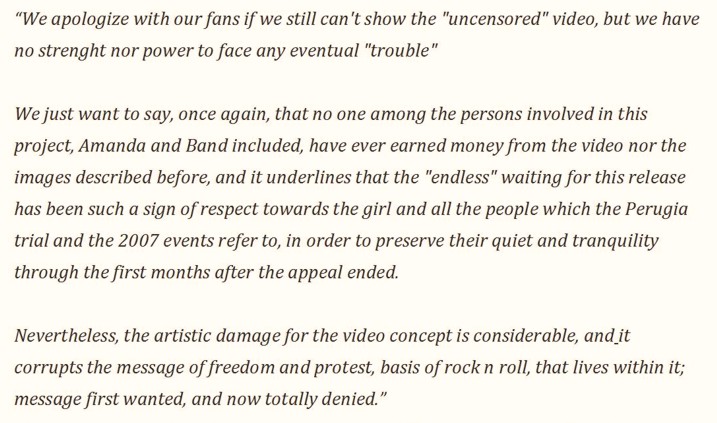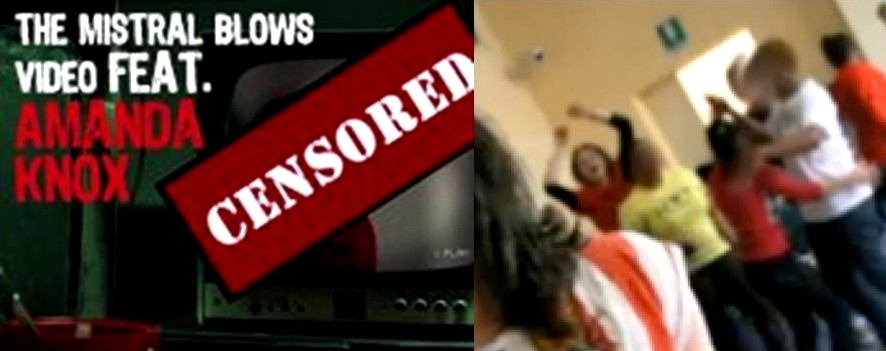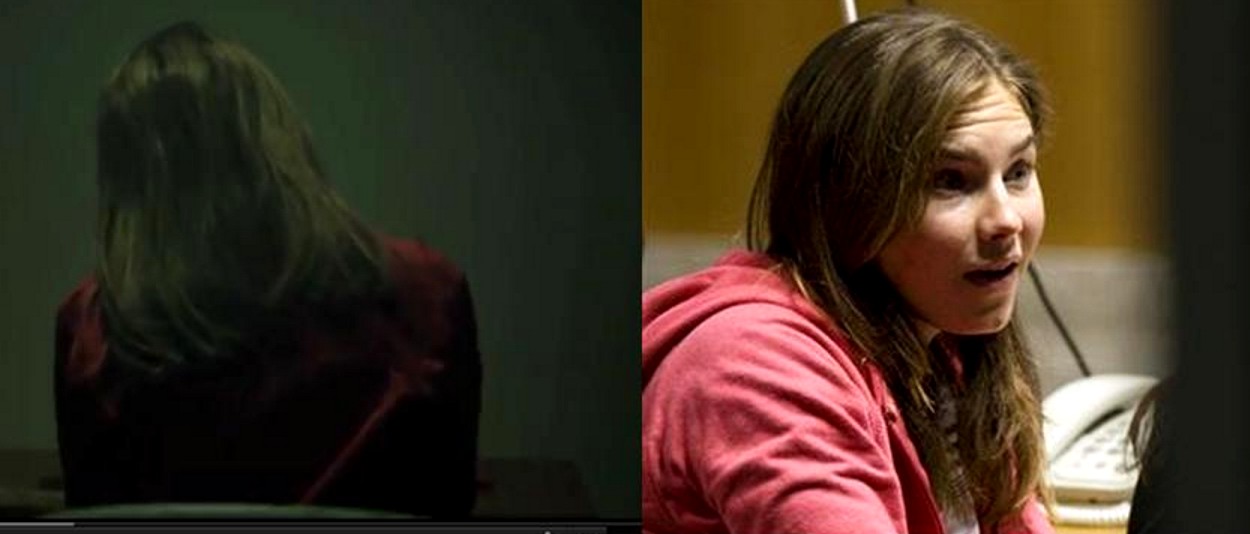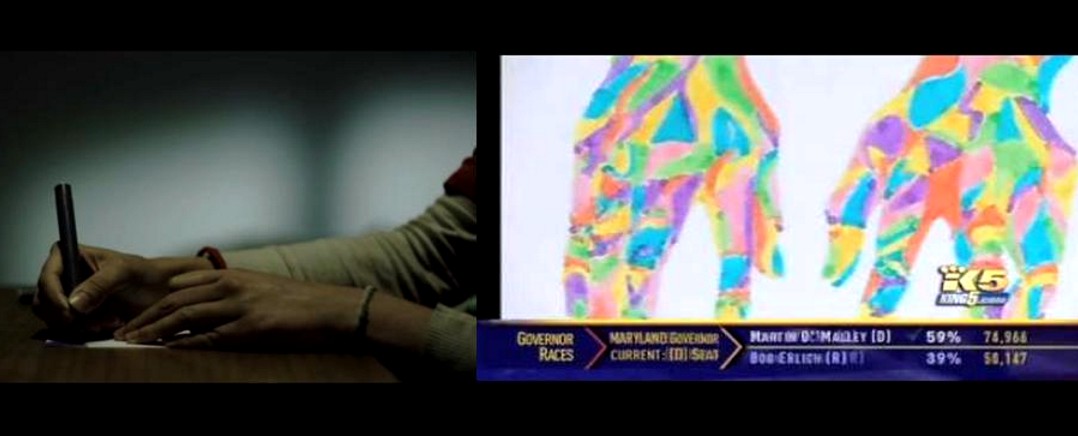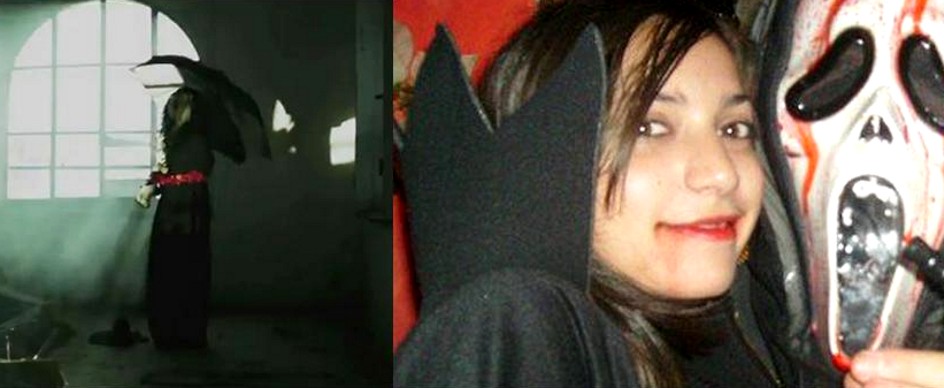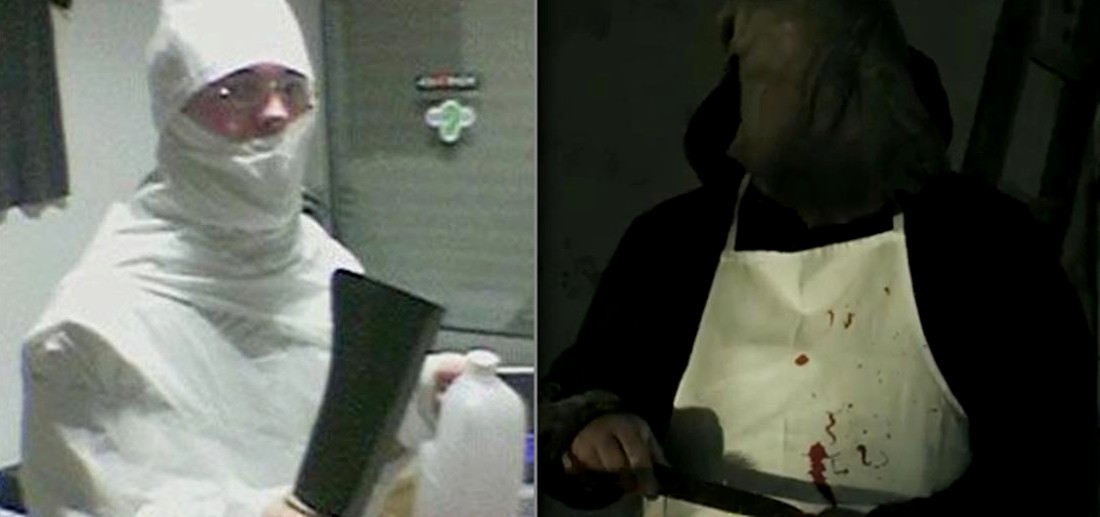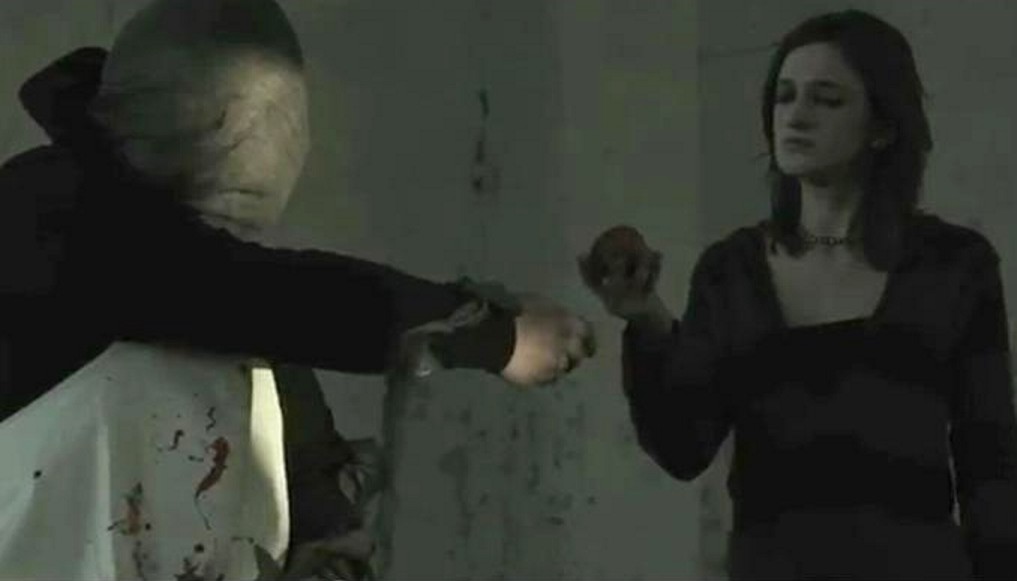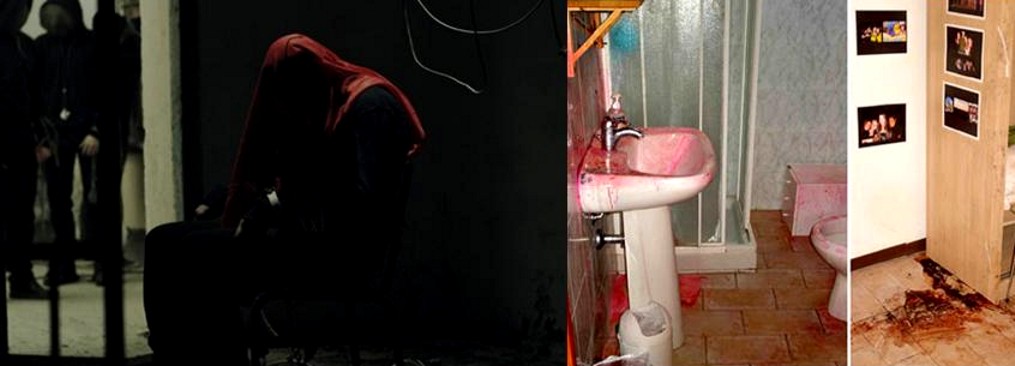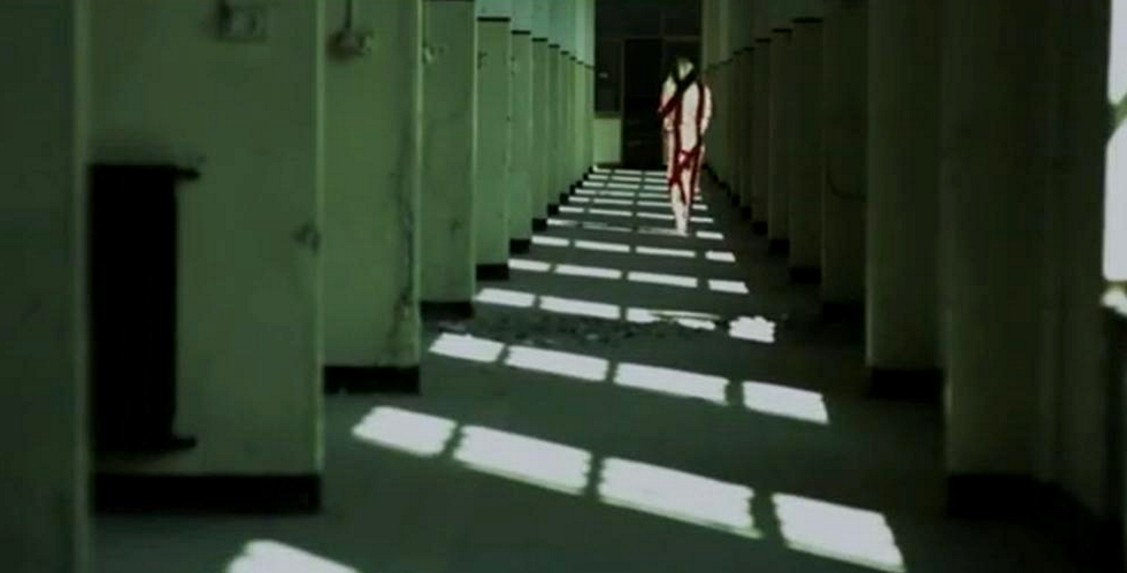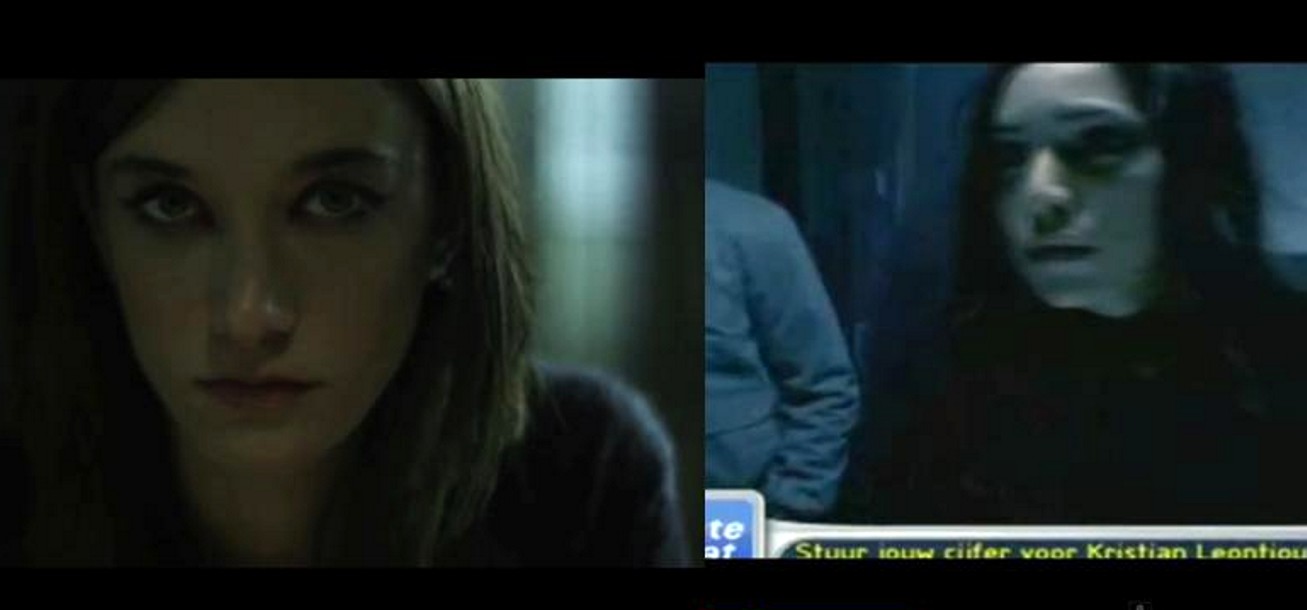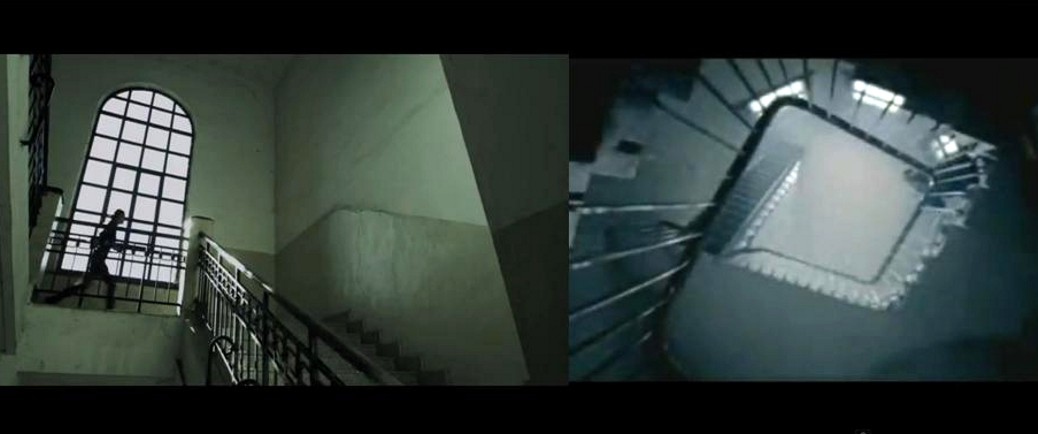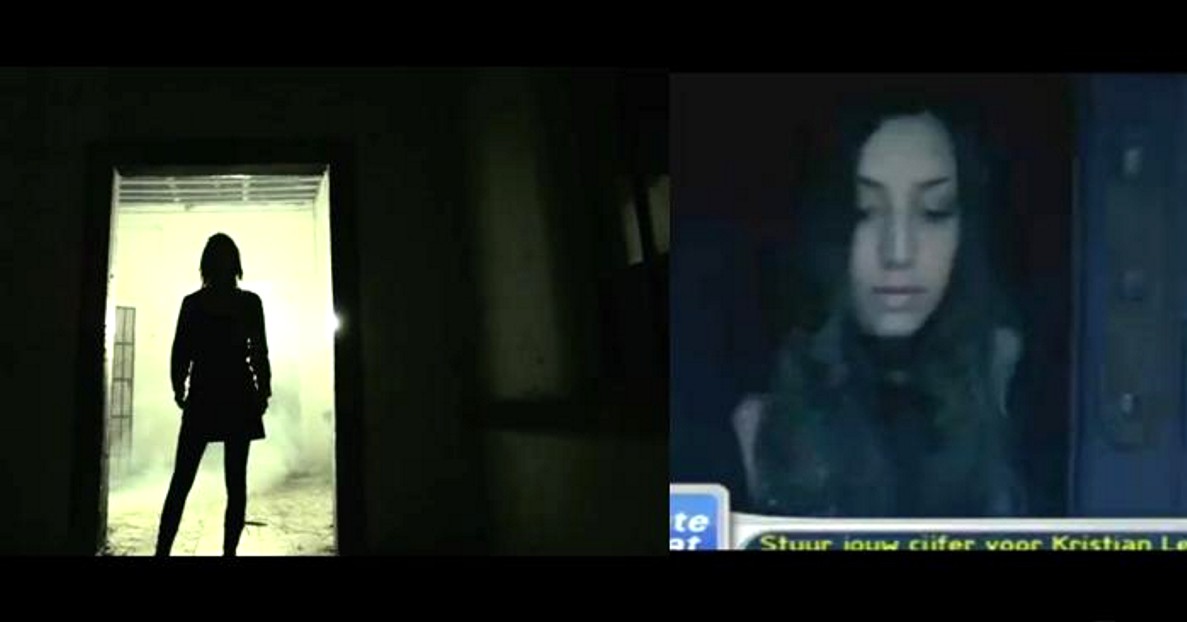
Category: The officially involved
Friday, September 21, 2012
The Rather Strained Couric-Sollecito Interview: Reading Between The Lines (2)
Posted by James Higham
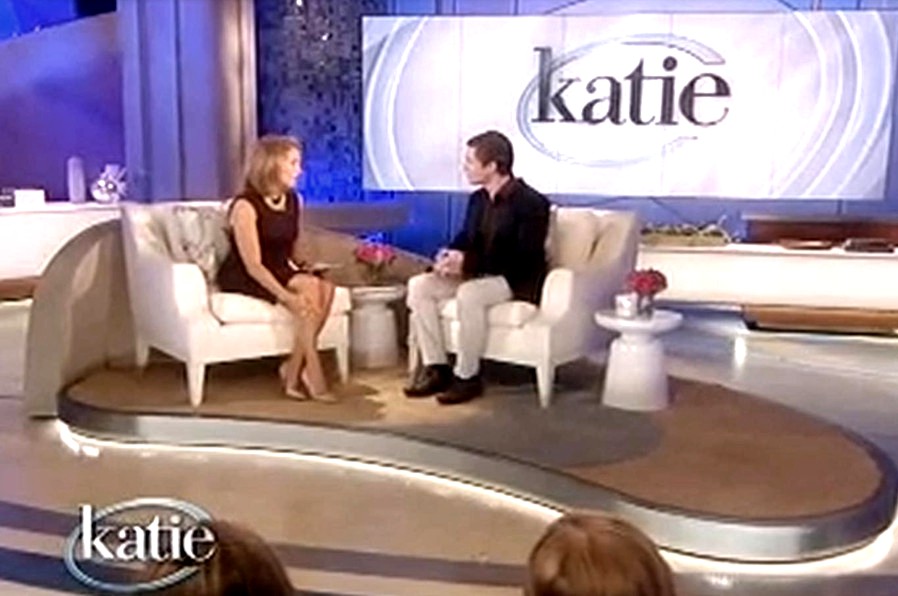
Katie Couric interviewed Sollecito, more briefly and frostily than expected, last Tuesday afternoon in New York. You can read the transcript here.
Sicily based blogger Welshcakes Limoncello commented on a summary of the interview I posted on my own website. “Do you think we will ever know the truth?”
It was a neutral statement, one so many must have made around the world when they considered the case in as much detail as the media allowed. The short answer, for those who’ve gone into the evidence in as much detail as PMF, TJMK and dozens of others, including me have, is a resounding: “Yes, we do actually. We are as sure as any court needs to be or has ever been, short of a signed confession.”
This is not an even playing field in the least. The evidence points one way, the professionals in the field concur, the Kercher family who, one needs to remember, were neutrals in the sense of whoever emerged as the killers they’d be down on, have sat through every bit of evidence as it was presented and they concur. Nineteen justices who reviewed the case concurred.
One can’t just sweep that under the carpet, claiming there was “zero evidence”, not when that time and effort when into gathering and considering it all, not when consideration of the evidence presented filled hundreds of pages. Just what are people trying to pull, claiming there was “zero evidence”?
And the defence ““ it hasn’t chosen to attack pieces of evidence [around 130 pieces of it] which they know they can’t attack. They picked on two main pieces in the appeal and failed to establish either, except in the minds of Zanetti and Hellman, the appointee who came in when the original trial judge was replaced. Would he risk his reputation and hundreds of pages of scathing consideration of Hellman and Zanetti if there was zero in it in the first place?
I mean, at what point doe blind denial cease and the cumulative weight of evidence win the day? Not cherrypicking two pieces of evidence and the judges refusing to hear the rest. I mean cumulatively ““ all of it.
And cumulatively is the only way to approach this case ““ what the totality of evidence, not the cherrypicking, points to. The weight of that evidence, from the DNA to the false alibis and the phone calls, would be sufficient to put anyone away, let alone the Supreme Court view that there was most certainly more than one killer, a point Sollecito, in his Couric interview, does not pooh-pooh. Wasn’t that interesting? He hopes the Kerchers will one day find the killers.
Not only was Sollecito forgetful of what had already been given as evidence but he has shown himself an inveterate liar. When you accuse someone of being a liar, as a certain commenter at Orphans of Liberty is wont to regularly accuse me of, being asked to produce his evidence of that and then dropping into assertion and ad hominem with no evidence whatever, the outcome is not one of life and death.
In Sollecito’s case, it is ““ the death of Meredith Kercher. So, I’ve accused him of being a liar. Where is my evidence? See this post by the Machine of April 2009.
There comes a point when one wonders why most who are still supporting Knox and Sollecito are doing so. One can understand the family and close friends doing so against all the evidence but not people like that professor at John Jay University who made the same assertions, minus evidence and relied on his learned credentials to convince.
Minus evidence, minus evidence ““ it has to be repeated over and over.
[Below: a previous interviewee who was more in Katie Couric’s class]

Thursday, September 20, 2012
Dr Galati: Here On American TV Tonight Raffaele Sollecito Apparently Commits Felony Defamation
Posted by Peter Quennell
Right now, Raffaele Sollecito, an Italian, is swanning around the United States with the apparent sole purpose of making his home country look bad.
As he is still accused of murder and other felonies until the Supreme Court signs off on the case, and accused felons are normally never allowed to enter the US by Immigration, it seems Sollecito could be here in the US illegally.
This video above was recorded from the Anderson Cooper news program on CNN at 8:45 pm tonight.
Here Raffaele Sollecito claims to have been abused and threatened by interrogators and claims that the same thing happened to Amanda Knox. He implies that he held out for hours, and that Knox was interrogated for 10 hours.
This seems to our lawyers precisely the same kind of invented malicious claim against interrogators which has resulted in both Amanda Knox and her parents being sued for felony defamation (calunnia) by police officers present when she was interrogated.
We know that both Sollecito’s own father Francesco AND HIS LAWYER Mr Maori have just indicated on national Italian TV that Sollecito was lying when he made this and other claims in his book. He has zero evidence to prove it, and he cannot point to anyone who abused him.
Sollecito had more than four years at trial and appeal and on national TV and privately with his lawyers to lodge such charges of abuse - and yet he never did. Not once did he ever advance them even though they might have got him off.
He did not even mention it in his nationally televised interview in Italy soon after he was released. He had to come to America to start making it - as blackmail, to make the Knox forces get him a resident visa? .
What do we believe really happened? This is from our July 2009 post on Sollecito’s many alibis.
Sollecito was asked to return to the police station on 5 November to answer some more questions. He was at that time confronted with telephone records that proved that he and Amanda Knox had lied previously.
So for his third alibi, which now cut Amanda Knox loose and implicated her, Sollecito claimed that he was at his apartment all evening, and that for part of the evening Knox was out, from 9 pm to 1 am.
In my previous statement I told a load of rubbish because Amanda had convinced me of her version of the facts and I didn’t think about the inconsistencies…..
Amanda and I went into town at around 6pm, but I don’t remember what we did. We stayed there until around 8.30 or 9pm.
At 9pm I went home alone and Amanda said that she was going to Le Chic because she wanted to meet some friends. We said goodbye. I went home, I rolled myself a spliff and made some dinner.”
He goes on to say that Amanda returned to his house at around 1am and the couple went to bed, although he couldn’t remember if they had sex.
How did things proceed from there? Did Sollecto or his lawyers claim that he had been tricked or abused into a “confession” ? No…
This third alibi was undercut by Amanda Knox when she took the stand and testified. She stated that she was with Sollecito at his place all night.
It was also contradicted by the forensic evidence presented by the prosecution: the four separate pieces of forensic evidence that placed him in the cottage on Via Della Pergola on the night of the murder.
This third alibi was also undermined by the telephone records and by the data taken from his computer.
Sollecito claimed that he had spoken to his father at 11 pm. The phone records showed that to the contrary, there was no telephone conversation at this time, though Sollecito’s father had called him a couple of hours earlier, at 8.40 pm.
Sollecito claimed that he was surfing the internet from 11 pm to 1 am. Marco Trotta, a police computer expert, testified that the last human interaction on Sollecito’s computer that evening was at 9.10 pm and the next human activity on Sollecito’s computer was at 5.32 am.
Sollecito said that he downloaded and watched the film Amelie during the night. However, Mr Trotta said that the film had been watched at around 6.30 pm, and it was earlier testified that Meredith returned to the cottage she shared with Amanda Knox at about 9 pm.
Sollecito claimed that he had slept in until 10 am the next day. There was expert prosecution testimony that his mobile phone was actually turned on at 6.02 am. The Italian Supreme Court remarked that his night must have been “sleepless” to say the least.
This alibi was undermined by the eyewitness Antonio Curatolo, the watcher in the park above the house, who testified that he saw Sollecito there.
From 2007 to 2011 Solleceto was rather notorious for NOT reaching out to Amanda Knox during trial and appeal and for NOT fully supporting her alibi. He has never retracted the statement that she was absent from his house from 9:00 pm to 1:00 am on the night Meredith was murdered.
This may be giving the Knox-Mellases some grins. They despise Sollecito, and they know full well of his treachery toward Amanda during trial when his own lawyer Bongiorno repeatedly blamed Knox (scroll down). They are presumably appalled at his loose lips and dishonest book which mess with her own prospects. .
the book’s title is a living lie. There is nothing honorable about him. And he is acting treacherously and cowardly toward his own country.
Wednesday, September 19, 2012
The Rather Strained Couric-Sollecito Interview: Reading Between The Lines (1)
Posted by Hopeful

Raffaele’s physical appearance was okay. He was groomed and dressed well. I alternately felt sorry for him and grossed out by him when I sensed he was lying from a cunning script.
He has taken a page out of Amanda’s playbook by using English instead of his native Italian with a translator, so the audience will identify with him and so he can buy time to formulate safe answers. He wants to show off to Amanda that he is as quick to master language as she is.
Katie Couric definitely put him on the defensive. Her maturity and restraint honed over years of interviews gave her the advantage. It must be so hard to smile and remain polite when you harbor suspicions you’re talking to a liar and stonecold killer. Her civility and training stood her in good stead.
She didn’t reveal too much disgust, but some slipped out. She did poke and prod for hard truth as much as possible within the limited format.
I think the biggest clue to Raffaele’s dishonesty was his refusal to denounce Meredith’s “real” killer, Rudy Guede. Had he not been part of the violence or obstruction of justice against Meredith, he would have the moral high ground to express natural horror rage and resentment against this “real” killer, a killer whose act has also destroyed Sollecito’s life.
If he were totally innocent, Raffaele would want only to name and shame Guede and howl for the harshest punishment. If Guede had gotten me involved in such a nightmare I would blame him without regret and with no game-playing or fear of his lies. The fact that Raf does not dare to anger Guede and refuses to judge the known killer who has dropped Raf into a living hell is a sign of some perverse obligation to Guede, fear of Guede, or guilty knowledge or some unnatural response.
He refuses to denounce Guede, while he revels in his coverup for Amanda. This suggests he is part of the crime. He denounces prison loudly enough! He seemed to want to say that prison serves absolutely no purpose at all, incarceration accomplishes nothing. This is simply a reflection of how much he hated prison, not how little he deserved it.
His big glory seems to be bucking his family, and rejecting their good advice, while professing to understand they are blinded by love and concern for him.
His tone is condescending. No, he will spare his family nothing. He prefers to turn his back on their best interests (which would be to have a son who could earn a solid living and eventually help his father in old age or sister, has Raf ever thought of success as a gift he can give them? No, it seems he wants drama and destruction and waste).
While his book claims Dr. and Sister Sollecito were begging him to reveal the truth regardless of whether it hurt Amanda or not, he turns his back on them and on truth completely. His desire is to honor a wildcat female who used him and cost his father and sister everything.
What a mockery of real honor. He’s ready to save Amanda a prison sentence no matter how big a liar he must become or how much terror he brings to his family or expense and stress on them. His childish and mistaken attitude was that Amanda loves him, Amanda is all that matters.
Thus he becomes a foolish and destructive ennabler, saving Amanda from the natural results of her own bad acts that would finally teach her something real. He wants to rescue her and his vanity since she reflects his romantic choice and he doesn’t want that criticized.
He will rescue her at cost of destroying the family who has truly loved him and stood by him, even though he has so many unresolved issues with them. I think this is because he has not felt strong enough to stand up to his family in the normal teenage years of establishing boundaries, usually through mild rebellion.
His fear of losing his father since he was motherless, or their overbearing powerful personalities (doctor and policeman) left his growth undone at the normal time. He is still a child. But his role in this crime has become a way out for him.
Raf is in hog heaven. He can emigrate from Italy to the U.S. for survival reasons that his folks must understand, since they assure him they don’t want him in prison. This is his way to get others to boot him to where he wanted to go all along. (Munich wasn’t far enough, and he was soon back home dejected.)
His biggest joy seems to be deceiving the police. His sister’s biggest mistake was doing shady stuff to help this ingrate brother, and his father will learn the same lesson.
It’s really sad because Dr. Francesco Sollecito Senior deserves better than this from his only son. Raf wants to lower the bar on their expectations of him. In that he has succeeded. His main goal is to disappoint his father and compromise his sister since he cannot compete with their workplace achievements and no longer has a mother to protect.
Raffaele took another page from Amanda by giving a lengthy and ambiguous answer to the question, “What would you say to people who still think you are guilty?” He never gets around to categorically denying he killed Meredith! Instead he harps on the media having deceived the public.
Of course the fog of nonsense is his own and Amanda’s.
Monday, August 20, 2012
Dissecting The Hellmann Report #4: The Contortions To Dismiss Witness Quintavalle
Posted by Cardiol MD

[Above: Images of Mr Quintavalle’s Conad store; he serves at far left, his cashier serves at far right]
Scroll down here for previous posts in this series.
Mr Quintavalle owns the Conad franchise at the lower end of Via Garibaldli, about halfway between Meredith’s place and Sollecito’s. Judge Massei in his trial sentencing report had stated this about Mr Quintavalle on page 83:
This Court deems that the testimony of Quintavalle is reliable. It was discovered that Inspector Volturno did not ask Quintavalle if, on the morning of November 2, he saw Amanda Knox in his shop.
He was asked ““ so Quintavalle recalled - about purchases made by Raffaele Sollecito. Mr. Quintavalle did not say anything about having seen Amanda Knox on the morning of November 2, 2007 in his shop because he was not questioned about this and because, as indicated by Quintavalle himself, he considered this fact to be insignificant.
This post exemplifies how the Hellmann-Zanetti web of deception uses a flood of reasons-to-doubt in its attempt to discredit Massei’s conclusion that Quintavalle was a reliable witness. Remarkably, the judges did not even recall Mr Mr Quintavalle, and mostly they work from the brief summary of his testimony in Massei’s report and little else.
Quintavalle’s testimony is key to the guilty verdicts against Knox and Sollecito, and contrary to Hellmann-Zanetti’s improper purpose; therefore they proceeded to systematically “disprove” Massei’s conclusion, stating this on page 39:
Indeed, Quintavalle asserts that she left without having purchased anything.
Verbatim from the hearing of March 21, 2009:
The Hellmann report here proceeds to selectively quote the hearing-transcript in a manner contrary to the usual and customary English-language meaning of “verbatim”. It may be that Hellmann-Zanetti meant to indicate that only the words they did quote were verbatim, and that their ellipses indicated innocent omissions. However the effect of their omissions is not innocent.
“¦If they had asked me”¦also because, I repeat, I, when the young lady came into my store, I did not see her leave with anything, because when she passed by and passed by again, when she left and I saw her, out of the corner of my eye I saw her leaving, I did not see that she had a shopping bag or anything in her hands.
PRESIDING JUDGE [PRESIDENTE]: You are speaking of the morning of November 2?
ANSWER: The morning of November 2. I don’t know if she bought anything, I don’t know. My cashier doesn’t remember if she bought anything, I am not able to say whether she bought something or not”¦”
If one wanted to maintain that perhaps Quintavalle is wrong, because she actually did purchase something, it would be correct to observe that if he could be wrong on this point, and also about the clothing she was wearing, then he could also be wrong about the identification of the young woman [giovane] as Amanda Knox.
Finally, the testimony of the witness Quintavalle does not seem reliable, and, in any case, represents an extremely weak piece of circumstantial evidence.”
Examples of Hellmann-/Zanetti’s flood of Reasons-to-Doubt [That AK/RS are Guilty] :
From Hellmann-Zanetti pages 39-43:
“Quintavalle
Another piece of evidence [uno degli elementi] on which the Court of first instance based its conviction of guilt is represented by the testimony of the witness Quintavalle, owner of a grocery store in Corso Garibaldi, not far from Sollecito’s house but also just a few minutes from via della Pergola: he in fact asserted that he saw, early in the morning of November 2, a young woman enter[sic] his store after having waited for it to open, whom he later recognized as Amanda Knox.
According to the prosecution (and to the Court of first instance), this circumstance proves that, contrary to the alibi she gave, she did not sleep at Sollecito’s house until late in the morning, but went very early to Quintavalle’s store, as she urgently needed to acquire a cleaning product suitable to clean the house in via della Pergola of her own traces and those of Raffaele Sollecito, before the police could intervene and take samples, since it was inevitable that sooner or later the alarm would be given because of what had happened.
In reality, even under the assumption that the circumstance is true, this would be a weak piece of circumstantial evidence, incapable in itself of proving guilt even presumptively; but in any case this Court holds that the testimony of the witness is not very reliable, in particular in what concerns the identification of the early”morning client with Amanda Knox.”
(1) Reason-to-Doubt #1: “”¦INCAPABLE IN ITSELF of PROVING guilt even presumptively”¦.”
The reader is being steered away from a level of doubt that is beyond-reasonable, and towards the territory of reasonable-doubt-that -AK/RS-are-Guilty.
“INCAPABLE IN ITSELF” improperly isolates the issue from all the other considerations which should simultaneously-be-taken-into-account.
“PROVING” improperly implies an inappropriate standard of “˜certainty’.
“¦.this Court holds that the testimony of the witness is NOT VERY RELIABLE, in particular in what concerns the identification of the early”morning client with Amanda Knox.
Logically “not very reliable” does not exclude “reliable” but Hellmann-Zanetti presumably don’t intend to concede that Quintavalle is reliable; this betrays Hellmann-Zanetti’s extreme bias and determination to exclude Quintavalle’s damning identification of [their client?] Knox.
Later on page 38:
In fact, he presented himself to the police only a year later, following intense urging by a young apprentice journalist”¦..”
This is a misleading reference to Antioca Fois; see Massei page 84:
He later spoke about having seen Amanda Knox because a young man who used to live above his shop, who he knew, Antioco Fois, had just graduated and had become a freelance reporter for the newspaper Giornale dell’Umbria. When he passed him, he would sometimes ask: “But do you know anything? Did you see something? Did you hear something?”
So one day Quintavalle told Fois that he had seen Amanda Knox on the morning of November 2; later he decided to go to the Public Prosecutor’s Office because Antioco Fois convinced him that this fact might be important.
So the “intense urging” was more like friendly exchanges with Quintavalle’s neighbour, a former lodger.
(2) Reason-to-Doubt #2: “In fact, he presented himself to the police only a year later”¦.”
Readers are invited to mistrust Quintavalle because he belatedly told this to the police for an untrustworthy reason, steering them further away from a level of doubt [with regard to Knox/Sollecito guilt] that is beyond-reasonable, and further into territory that is reasonable-doubt of their guilt.
Later still on page 38:
Now, what actually happened more than a year before Quintavalle presented himself to the police is absolutely not irrelevant, for the purpose of evaluating the reliability of the witness, especially from the point of view of the genuineness of his memories and the exactness of the identification.
(3) Reason-to-Doubt #3: “absolutely not irrelevant, for the purpose of evaluating the reliability of the witness”
This double-negative statement further invites Readers to regard Quintavalle as unreliable because his memories are false, and his identification of Knox is too inexact. Steering Readers yet further into a level of doubt of Knox’s guilt that is reasonable-doubt.
Yet further down on page 38:
“¦..this was a witness who ““ taking into account what he himself explained ““ took a year to convince himself of the precision of his perception, and the exactness of the identification of Amanda Knox with the girl that he saw, although he was able to appreciate the relevance of his testimony already in the days immediately following the murder.
(4) Reason-to-Doubt #4: “..took a year to convince himself…”
From Hellmann-Zanetti page 36:
“¦..took a year to convince himself of the precision of his perception, and the exactness of the identification of Amanda Knox with the girl that he saw, although he was able to appreciate the relevance of his testimony already in the days immediately following the murder.
Repetition of reader-invitation to regard Quintavalle as unreliable, because his perceptions are not precise enough for Hellmann-Zanetti, and his identification of Knox was too inexact even though he knew at that time that his testimony was crucially relevant.
The reader is being steered even further away from belief that Knox and Sollecito are guilty towards the territory of reasonable-doubt-that -AK/RS-are-Guilty.
Are we there yet? Is there reasonable-doubt-that-AK/RS-are-guilty NOW?!
(5) Reason-to-Doubt #5: “Quintavalle cannot maintain that…”
Near the bottom of Hellmann-Zanetti page 38:
...from the testimony of Inspector Volturno at the hearing of March 13, 2009, it turned out that Quintavalle and his employees and other shopkeepers in the area were shown photographs of Raffaele Sollecito and Amanda Knox, and were asked in particular to mention any possible purchases of cleaning products on the part of the couple, as this was a precise focal point of the investigation. Thus, Quintavalle cannot maintain that he did not mention what he saw on the morning of November 2 to Inspector [53] Volturno because he did not think it was a relevant circumstance.
Readers are yet further invited to mistrust Quintavalle, because his failure to “mention” everything he had seen, and his idea of “a relevant circumstance” were unacceptable to Hellmann-Zanetti.
That’s already five reasons to doubt on the first Quintavalle page alone.
See also Hellmann-Zanetti page 42:
....according to Quintavalle’s own statements ““ he only caught a glimpse of the girl, first out of the “corner of his eye” and then from a bit nearer for a few moments, but never from the front (verbatim from the hearing of March 21, 2009: “Yes, then she entered, I saw her let’s say like this, three quarters left, three quarters of the left side. I didn’t see her from the front”¦”
And Hellmann-Zanetti page 43:
“....when she left and I saw her, out of the corner of my eye I saw her leaving,”
Hellmann-Zanetti are now reduced to semantic quibbles about Quintavalle’s use of words to describe his visual-angle-of-view when he looked at Amanda Knox’s face.
But see Massei page 83:
This young woman remained impressed in his memory because of her very light coloured eyes, azzurri [light blue]. “¦. she could have been 1.65 to 1.67metres tall. Her face was bianchissimo [very light skin colour] and she apparently was about 20-21 years old.
And see Massei page 84:
...it is worth observing that the witness gave a precise description of what he saw on the morning of November 2 and also provided a description of certain physical features of the woman he saw (light blue eyes and pale face) which, together with the unusual time, may well have fixed in his memory what Quintavalle said he saw.
So by selective omissions of the contents of the Massei Report, based on the 4-dimensional observations of the Massei trial hearings, Hellmann-Zanetti use a 2-dimensional record of the Massei Proceedings, and semantic quibbles about Quintavalle’s angles of visual observation, to discredit Quintavalle’s testimony.
Even though Quintavalle - who the Hellmann-Zanetti jury never even saw - had testified convincingly at trial that it was Amanda whom he saw in his shop at opening-time on November 2, 2007, and he had held up well under cross-examination.
Enough already? Isn’t this a contorted flood of Reasons-to-Doubt-That-AK/RS-are-Guilty? Do you now believe that Quintaville is an unreliable witness?
If you now believe that Quintaville is unreliable, then Hellmann-Zanetti will have accomplished their mission.
[Below: Conad is at right and School for Foreigners at back. RS’s place maybe 500 meters behind, up the hill]
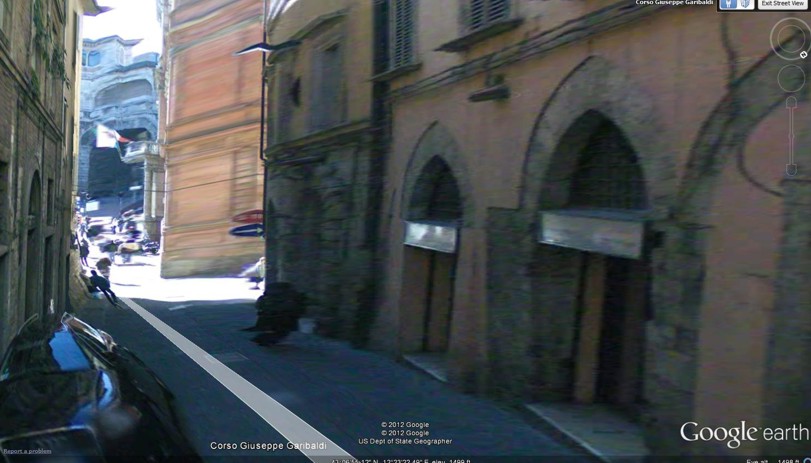
Thursday, August 02, 2012
Dissecting The Hellmann Report #3: How Zanetti & Hellmann Bizarrely Try Discredit Witness Curatolo
Posted by Cardiol MD

[Stone steps Meredith and all three accused maybe used on the night; left and at bottom, where witness sat]
Under the first post in this series dissecting The Hellmann Report, one of our percipient commenters suggested this:
The next portion in the series should likely be about the witnesses, I hope, and there we can marvel at Hellmann’s discourses on the functioning of the human memory.
Was our commenter ever right!
On page 32 of the PMF English language version of “Sentence of the Court Of Assizes Of Appeal Of Perugia (Presided Over By Dr. Claudio Pratillo Hellmann)” this is written:
The presence of Amanda Knox and Raffaele Sollecito in Piazza Grimana between 9:30 PM and 11:30 PM on November 1 was, in fact, reported solely by the witness Curatolo, whose reliability this Court very much doubts for the following considerations.
In the first place, the deterioration of his mental faculties, from his way of life and his habits. revealed by his answers before this Court in the course of his testimony (hearing of March 26, 2011) resulting from his way of life and his habits
Realisation of what Hellmann/Zanetti were “constructively” doing there stunned me. They are exposing both a lack of logic and prejudice against a witness.
A necessary logical preamble to my realisation goes as follows:
- 1. Massei had stated that Antonio Curatolo’s declarations have “been established to be reliable” [MASSEI p.358 of 397 [28th of 42 total Curatolo references]].
2. Hellmann/Zanetti stated that “..this Court does not recognise the statement made by the witness Curatolo as credible”¦ [Hellmann/Zanetti p35 of 95 [5th of 18 total Curatolo references]]
3. In American common-law appellate courts do not rehear the facts of the case. Appellate courts focus on questions of law, NOT on questions of facts as their trial-courts do.
The American appellate judges don’t presume to supersede the people who were there, and who watched the witness’s demeanour and surrounding activity, in 4-D (3-D + Time), with sights, sounds, cadences, pauses, pronunciations, intonations, and yes, “¦smells, in addition to, and supplementing, the 2-D pieces of paper, containing only the words they apparently spoke, but not containing the way they spoke them, let alone the scene before the court.”
The American appellate judges want only to know whether the law was applied accurately.
Those American appellate courts overrule a trial court decision only if a very important legal error was made in the trial court.
In some cases, the American appellate court judges might believe that the outcome of the trial court should have been different, but if no legal errors were made, they will not overrule the lower court.
The American appellate judges make their decisions based only on legal arguments of how the law should be applied and interpreted.
Our learned English & Welsh Common Law (E&W) correspondent has explained to us that E&W law permits Appellate introduction of fresh evidence, which could include new evidence re rain and buses, although Massei had already considered evidence on those subjects.
E&W Law would not have allowed Appellate re-examination of Curatelo.
4. As we all know, and have discussed in some detail, Italian law is significantly different but Dr Galati is apparently outraged by the conduct and Motivazione of Hellmann/Zanetti.
Dr Galati has lodged a strongly-worded Appeal of Hellmann/Zanetti’s verdict, alleging that the scope of Hellmann/Zanetti was illegal and that they tried to run a whole new appeal trial.
Galati indicated in the appeal to Cassation that the Hellmann/Zanetti reveals “contradictoriness/contrariness and demonstrates manifest illogicality in the grounds for the judgement/reasoning report””¦
See also my previous post on the definition of “unreliable” [in the Hellmann Report] with reference to the witnesses Antonio Curatolo.
Although I can identify no specific reference by Dr Galati to the specific issue re Curatolo I wish to address, this one should have been included:
- i. “the deterioration of his mental faculties”, apparently between Curatelo’s testimony at the Massei hearing of March 28, 2009, and Curatelo’s the Hellmann/Zanetti hearing of March 26, 2011.
ii.Suppose Curatolo’s faculties really did deteriorate during those 2 years; maybe he was injured in an RTA, had a stroke, or developed a dementia.
What on earth has that got to do with Curatelo’s testimony back in 2009? It’s possible that Hellmann/Zanetti were implying that Curatolo’s “deterioration” was part of a continuum, and that as bad as he was, in their opinion, in 2007, 2009, and 2011, he had been, and still is steadily getting worse.
If that is their implication they would be committing 2 cardinal errors of logic ““ the interpolation error, and the extrapolation error.
Of course, giving their words their plain-meaning, Hellmann/Zanetti could be implying acceptance of the Massei’s statement that Curatolo’s 2009 testimony was reliable ““ but they obviously do not intend to imply that.
iii. Maybe Hellmann/Zanetti can get away with dismissing Curatolo’s testimony to Massei “presuming to supersede the people who were there, and who watched the witness’s demeanour and surrounding activity, in 4-D (3-D + Time), with sights, sounds, cadences, pauses, pronunciations, intonations, and yes, “¦smells, as well as the 2-D pieces of paper, containing only the words they apparently spoke, but not containing the way they spoke them, let alone the whole scene before the court. ”
I hope not, but with this “deterioration” allegation, there is no apparent (even an inadmissible one) professional expert opinion in evidence, and with Hellmann/Zanetti’s gratuitous cause-and-effect theory: “resulting from his way of life and his habits “, Hellmann/Zanetti overstep, and reveal their ignorance, arrogance, and incompetence.
Finality, in Anglo-American common law, is the concept that certain disputes must achieve a resolution from which no further appeal may be taken, and from which no collateral proceedings may be permitted to disturb that resolution.
Does Italian law really allow this 2-years-later Appeal-rehash of witness testimony and criticisms, on the grounds that the witness’s memories have faded since he first testified? I hope not.
Isn’t it normal for memories to fade with the passage of time?
Does that fading justify dismissal of the original testimony?
A principle of Anglo-American Common Law deeply embedded in it - Finality - would be out-of-the-window if lawyers could just keep repeating their questions until the witness gives them what they want.
Between their substitution of “certainty” for “reasonable-doubt” and their would-be eternal-postponement of finality Hellmann/Zanetti could shoot their legal system out of the courts.
Hellmann/Zanetti’s treatments of Curatolo’s testimony, alone, is a disaster. They should be thrown-out.
Hellmann/Zanetti’s subtext seems to be that Curatolo is merely an ignorant, illiterate, bad smelling, unkempt, dirty, ugly-old-tramp, daring to testify as to what he observed, to the detriment of two knowledgeable, educated, sweet-smelling, tidy, clean, attractive, young, innocent children.
Isn’t it far more certain, Hellmann/Zanetti seem to think, that the testimony of Curatolo is false testimony, and that the false testimony of these charming young children is not really false testimony because the Devil Prosecutors made-them-say-it.
If I analysed that whole section it would be very long.
If you are not yet familiar with them, you should read in conjunction with this series the posts by one of my lawyer colleagues on TJMK. James Raper, explaining the strength of the prosecution case and how hard it is to challenge legitimately.
See here and here. Also here by another of my lawyer colleagues, SomeAlibi.
[Below: witness said he and perps sat on benches at left; Meredith’s house far left, steps far right]

Friday, July 27, 2012
Heads-Up To The Amanda Knox Forces: A Case Showing How Closely The US and Italian FBIs Co-operate
Posted by Peter Quennell
Meet Doctor Mark Weinberger.
That report about his arrest in Italy was broadcast in 2009. We last posted on him here.
Weinberger was apparently a wildly successful doctor who ran a sinus clinic in Indiana and lived a wildly affluent lifestyle a few milers north outside Chicago. In 2004 he disappeared off his large yacht which was then anchored at a Greek marina, and for six years his (very impressive) wife Michelle presumed he was dead.
In the meantime she had found out that he had actually been running a huge fraud, scamming health insurance and the US government via false billing and unnecessary surgery (often botched) for many millions. And that far from being left comfortably off, she was financially wiped out.
In 2006 in absentia she divorced Weinberger and started over.
In 2009 Weinberger was captured in the Alps by the Italian equivalent of the FBI and returned to the United States as soon as his extradition was requested. In perhaps 99 percent of all US-Italian extradition cases, the fugitives are handed over by both governments very promptly. This sure wasn’t any exception.
Weinberger began to lose the first of numerous civil suits a year ago, and on wednesday he pleaded guilty to 22 criminal charges in federal court.
His prison term is set at ten years.
One moral of the tale apparently still not learned by Steve Moore and Bruce Fischer and their hapless ship of fools, so desperate for approbation, is this: much or most of the time it is the fine Italian equivalent of the FBI that they are misrepresenting and defaming.
In the past two weeks alone, we have seen new ramblings by Saul Kassin and Nigel Scott (engineered by Bruce Fischer) that to any informed lawyer are quite crazy. Kassin and Scott clearly didnt have the slightest idea WHO they were defaming or accusing of crimes.
Or how much more determined thier defaming makes the Italian FBI and other law enforcement agencies and the courts to give Amanda Knox (or Curt Knox or Edda Mellas) no special breaks.
The daffy Steve Moore first introduced this confusion way back here. And of course Bruce Fischer, Curt Knox’s hotheaded chief hatchet man, sustains it up to this day.
Eighteen months ago, Chris Mellas (whose business in Seattle is doing well) sensibly recommended from Perugia that the Knox campaign should finally acquire some cool heads and some REAL experts, and toss the trouble-making grand-standers they had acquired over the side.
Perhaps predictably, Curt Knox (whose business in Seattle is doing badly) reacted red-faced and steaming, and shot this seemingly quite smart idea down. So the abrasive, misleading, very amateur campaign goes on.
***
Added. We are now told that Frank Sforza and David Anderson are in Seattle, and Sollecito will be there soon, to actually jack up the level of defaming in the RS and AK “we were the victims” books being written.
Wow. THAT is Curt Knox’s end-game?l He ran that one past Chris Mellas? It seems universally believed in officialdom in Rome and Perugia that Curt Knox KNEW all along that Amanda did it. Apparently with good evidence.
What will he do if they charge him?
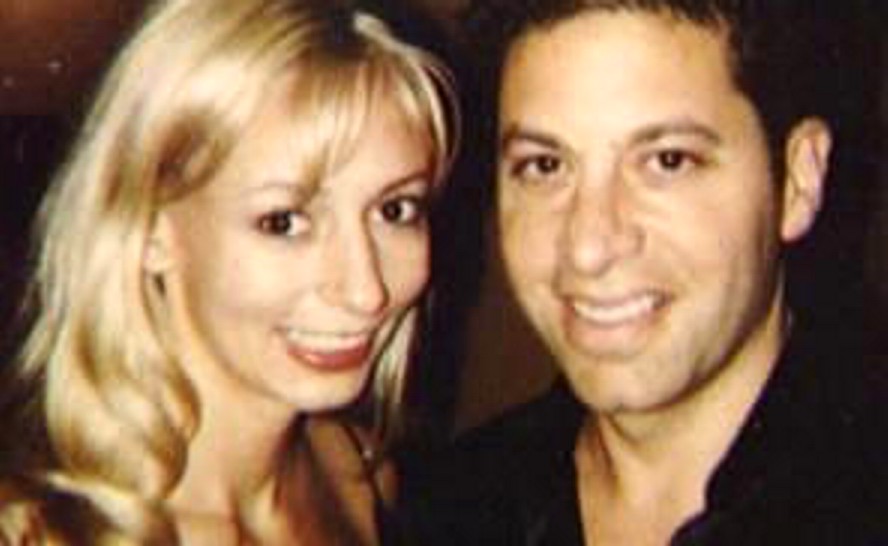
Tuesday, July 24, 2012
Dissecting The Hellmann Report #2: How Judges Zanetti And Hellman Tilted The Legal Playing Field
Posted by Cardiol MD
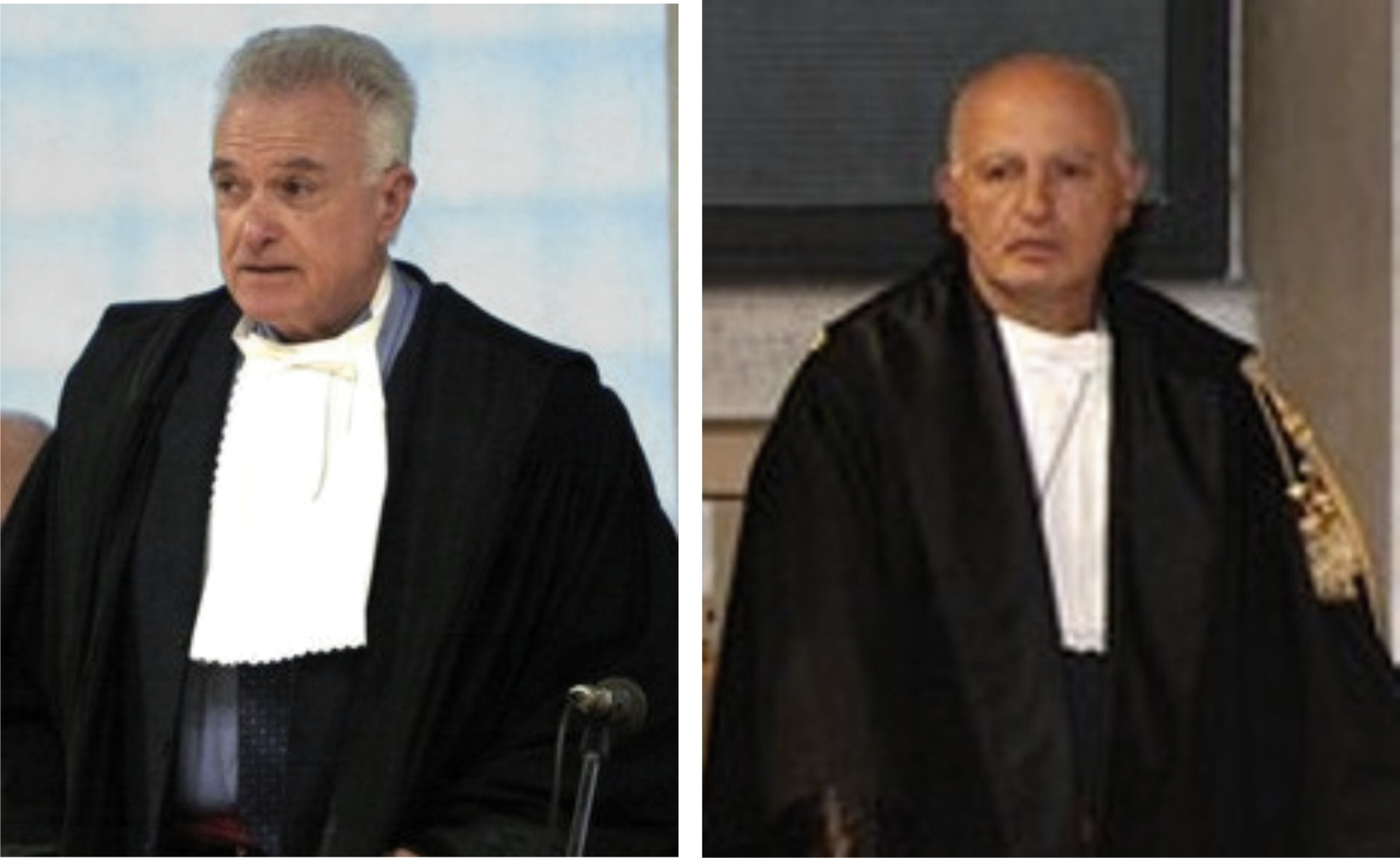
The Calunnia section of the Hellmann Report is about 4 pages in a 94 page document and it covers the Knox framing of Lumumba.
The Calunnia section was used in the first post of my series (“Dissecting The Hellmann Report #1: Highlighting Representative Examples Of Its Many Bizarre Quirks” ) to demonstrate the weaknesses typical of the whole report
Following publication of that post, it was kindly brought to our attention that the contributions of Assistant Judge Zanetti were so extensive - the report is said to be argued and written throughout in his style, and far from Judge Hellmann’s - that it should be called The Hellmann/Zanetti Report.
Post #1 exemplified, among other defects, some Orwellian DoubleThink from Hellmann/Zanetti:
Early in Calunnia, on Report page 22, Hellmann/Zanetti attribute Knox’s inconsistent, and incriminating, often illogical, falsehoods and behaviours, to Knox’s confusion caused by prosecutorial oppression, from which, by unspoken implication, guilt cannot be inferred, Hellmann/Zanetti informs its readers.
However, on page 23, still in Calunnia, Hellmann/Zanetti admonishes the reader not to infer any implication of guilt from the Knox falsehood that was the very subject of Calunnia, because the falsehood “is in fact not at all logical”.
The two relevant passages, using very convoluted language, “constructively” argue:
- Firstly, that if Knox uttered any falsehoods (including illogical falsehoods) it was because of prosecutorial oppression, is not evidence of guilt, and,
- Secondly, that if Knox uttered any illogical falsehoods, with or without prosecutorial oppression, it was because Amanda would not say anything illogical if it was easier to tell the truth than to tell something illogical, and is also not evidence of guilt.
Among the specific defects in the Hellmann/Zanetti Report, exemplified in its Calunnia section were the Report’s ploy of flooding the discussion of each evidentiary element with real and imagined reasons-to-doubt the significance of each element.
Report #1 also mentioned the issue of whether Meredith did scream just before she died, and if so when Meredith screamed.
Hellmann/Zanetti’s endemic use of the word “certain” revealed a biased perspective, as if “certain” (as in “beyond doubt”), is Hellmann/Zanetti’s equivalent to “beyond a reasonable doubt”.
This post in my series, “Dissecting The Hellmann Report #2”, focuses on the whole Report’s constructive substitution of “certain” for “beyond a reasonable doubt”:
First we take into account a semantic quirk: In the English language the word “certain” is used in multiple senses. In the Italian language, its Italian-equivalent the word “certo” is used in a much narrower sense.
Generally, when absence-of-doubt is intended, a verb-sense is used e.g. “It is certain”. In contrast when a figure-of-speech-sense is intended an adjectival or other modifier-sense is used e.g. ”“¦a certain smile”¦”.
The Hellmann/Zanetti English translation-draft uses both of these senses.
It uses the figure-of-speech sense 12 times, but where the absence-of-doubt sense is constructively intended, it uses forms like “certainly” (41 times), “certain” (36 times), and “certainty” (11 times), for a total of 88 times.
Other ways of expressing certainty are also used.
Judge Zanetti is the one who made “opening statements” variously reported to have been “”¦nothing is certain except the death of Meredith Kercher.”, or “”¦ the only fact that is objectively certain, indisputable and that has not been discussed is the death of Meredith Kercher”.
Neither version of Judge Zanetti’s “opening statements” appears in the Hellmann/Zanetti English translation-draft, although the draft does include references informing the reader that the report contains an error (see footnotes 2 & 3 in the draft, on pp 18 & 19)
The Chief Prosecutor, Dr Galati, both in his Appellate Brief for the Supreme Court and in his oral statement at his press conference, excoriated Judge Zanetti for his start-of-trial remarks:
The second-level [first appeal] judges appear to have shown “a sort of prejudice” with the “infelicitous preamble of the judge [the author], who is supposed to be impartial”, when he declared that “nothing is certain except the death of Meredith Kercher”, which to the others [Mr Galati and Mr Costagliola] is nothing more than “a resounding preview/forecast of the judgement” and a “disconcerting” affirmation.”
Here are some examples, emphases are mine :
Page 12 ““ “It is clear that if, for the sake of argument, the DNA found on the clasp is actually Raffaele Sollecito’s, this [piece of] evidence, while yet remaining such, is of particular significance: and the same can be said for the DNA found on the handle and on the blade of the knife seized at Raffaele Sollecito’s house, provided it is certain that this is actually one of the weapons used by the aggressors.”
Hellmann/Zanetti’s 1st explicit use of the idea of certainty, in the printed document, using a qualified “provided it is certain”.
Pages 16-17:
...About the footprints, they observe that those recovered from the inside of the residence reveal the presence of Amanda Knox and Raffaele Sollecito at the scene of the crime. These are prints that in the scientific view cannot be classed as usable for positive comparisons but, however, are useful for negative comparisons, in the sense that, based on these prints one cannot reach a certain identification [23] but one can, however, arrive at a certain exclusion on the basis of the compatibility, or not, of these prints with a specific subject.
The Scientific Police (Inspector Rinaldi and Chief Inspector Boemia) were able, thus, to exclude that the footprints could be attributed, in contrast to the shoe prints, to Rudy Guede, while they were judged compatible with the characteristics of Amanda Knox (imprints recovered from her room and from the corridor) and of Raffaele Sollecito (imprints recovered from the small mat in the bathroom and in the corridor).
Hellmann/Zanetti here argue that the idea of ”˜certainty’ is asymmetric (my paraphrase), it may not justify certain inclusion, because of its mere compatibility, but it may justify certain exclusion because of its incompatibility.
This is valid and historically well-accepted; Massei had already said so.
Pages 20-21:
And so, the re”examination of the outcomes from the first instance trial, and the subsequent acquisitions [of evidence] during oral argument in the current appeal, do not confirm the hypothesis that more than one person was necessarily involved in the crime.
This hypothesis, as appears from a reading of the December 22, 2009 judgement, was shaped by substantially accepting all the arguments presented by the Prosecution and in particular holding the following items to be certain:
““ that the DNA, recovered by the Scientific Police from the bra”clasp in the murder room, be attributed to Raffaele Sollecito and that this DNA had been left behind precisely during the occasion of the murder; [28]
““ that the DNA, recovered by the Scientific Police from the blade of the knife seized in Raffaele Sollecito’s house, be attributed to Meredith Kercher and that it had been left behind during the occasion of the murder;
““ that the wounds present of the body of Meredith Kercher, by their number and their directions, as also by their various characteristics (length of wound, width, etc.), could not have been occasioned by a sole aggressor but by multiple aggressors;
““ that the absence of defensive wounds on Meredith Kercher’s hands and arms confirm the necessary participation of more than one person in the aggression; ““ that the ingress into the interior of the via della Pergola apartment had been allowed by the only person who, in that moment ““ apart from Meredith Kercher ““ had the means of doing so, that is to say, by Amanda Knox, the Court of Assizes of Appeal having held that the ingress through the window, by means of breaking of the glass, was no more than a mise”en”scène to falsely lead the investigations towards unknown authors of an attempted theft.”
Hellmann/Zanetti here lay a reasonably neutral factual-foundation, before launching their attack.
Page 30. re [42] Defense-witness-statements of Alessi, Aviello, Castelluccio, De Cesare, Trincan:
“¦.If these testimonies cannot be considered as evidence in favour of the present accused, this does not mean, however, that they can be considered ““ as argued by the prosecution ““ as circumstantial [evidence] against them. That these witnesses decided to report such circumstances, hypothetically in favour to the accused, either spontaneously or solicited by others is of no importance; it is certain that there is no evidence to maintain that it was the present accused, (who did what?) arrested a very few days after the event and, therefore, held in prison for years, to plot such a plan, so that the unreliability of [43] these witnesses cannot be considered as confirmation that the defendants provided a false alibi.
Hellmann/Zanetti here slip-in an unnecessary, incomplete, assertion to protect the false alibi. It was already obvious that those witnesses were brought-on in defensive desperation to distract, and didnt seem important to the issue of the false alibi, one way or the other.
[Added: Cardiol edit of 7 Aug. 2012: Until the translation by PMF of the first half of Galati’s Appeal reached me on 6 August after writing this, most of us did not realise that Hellmann/Zanetti had improperly omitted, selectively & deliberately, Aviello’s statements which in fact are crucially important, not only to the issue of the false alibi, but also to the issue of AK/RS’s very guilt. Therefore I retract the “didnt seem important” above. Hellmann/Zanetti’s “slip-in” seems deliberately incomplete, to protect their own criminal misconduct.]
Page 49:
3. Taking into account that none of the recommendations of the international scientific community relative to the treatment of Low Copy Number (LCN) samples were followed, we do not accept the conclusions regarding the certain attribution of the profile found on trace B (blade of knife) to the victim Meredith Susanna Cara Kercher, since the genetic profile, as obtained, appears unreliable insofar as it is not supported by scientifically validated analysis;
Hellmann/Zanetti here buy into the questionable DNA testimony (“not supported by scientifically validated analysis”) of Stefano Conti and Carla Vecchiotti, whose consultancy is called “˜illegal’ in the Supreme Court appeal of Chief Prosecutor Dr Galati.
More to follow in the next posts in my series.
If you are not yet familiar with them, you should read in conjunction with this series the posts by one of my lawyer colleagues on TJMK. James Raper, explaining the strength of the prosecution case and how hard it is to challenge. See here and here.
Also here by another of my lawyer colleagues, SomeAlibi.
Friday, July 20, 2012
Dissecting The Hellmann Report #1: Highlighting Representative Examples Of Its Many Bizarre Quirks
Posted by Cardiol MD
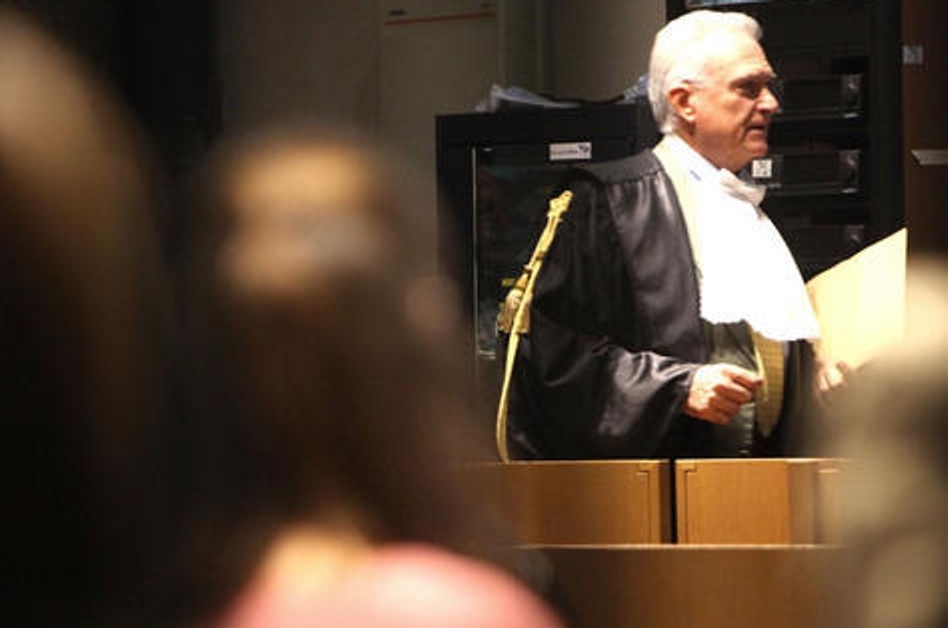
[Above: Judge Hellman. At bottom: Judge Zanetti, who may have written the sentencing report]
Milan and Rome are the main venues for Italy’s important business trials. Those in Perugia are small and relatively obscure.
In contrast Perugia handles very important criminal investigations for the central government when there are conflicts of interest in Rome. So Perugia was handed the very sensitive and politically explosive investigations into Rome politicians siphoning funds from the 2006 winter Olympics construction and the 2010 earthquake damage reconstruction.
This explains why Dr Galati the chief prosecutor for Umbria was transferred from the Supreme Court in January 2011 where he had been a deputy chief prosecutor and why he has a high profile throughout Italy. And why Judge Hellman, a business judge, is almost unknown outside Perugia who at times seems a little cranky with his lot in life. His co-judge Massimo Zanetti, also little known, handles civil trials.
Read in Italian, Dr Galati’s Supreme Court appeal against the Hellman/Zanetti appeal verdict which is some pages longer than the Hellman & Zanetti report, is absolutely scathing. (The team will have the PMF translation ready soon.) Dr Galati seems almost offended to be facing what he seems to see as a childish and legally inferior piece of work.
Dr Galati takes Hellman & Zanetti apart at three levels, as the Perugia media summarised at his press conference five months ago.
First, that the scope is illegally wide for an appeal judgement. Second, that the DNA report by Stefano Conti and Carla Vecchiotti (which concluded with innuendo rather than firm findings) was unnecessary at the appeal level and should never have been commissioned. And third that Hellman & Zanetti are out of order in their subjective interpretations of trial evidence their appeal court mostly didnt look at, and trial witnesses their appeal court never saw.
As a lawyer in the common-law systems of the US and UK I have read plenty of equivalent arguments by judges which logically and legally and objectively almost always hit a very high plane.
On the Hellman & Zanetti report I have to agree with Dr Galati. This seems a dismally inferior piece of work.
To me this document reads like the work-product of a naïve freshman law student in appellate procedure class submitted with no reasoned presentation of facts and evidence as a defendant’s brief, instead of as the official report of a Regional Court Of Assizes Of Appeal submitted in the name of the Italian People with a sober presentation of Facts and Evidence and a reasoned Explanation of Conclusions.
In my view and surely Dr Galati’s it deserves no more than an F.
The Hellman/Zanetti report is emotional and hyperbolic, but it is neither persuasive nor professional. Its faults are so densely packed that any TJMK series fully analyzing them would need more space than posting of the full Hellmann/Zanetti Report.
The calunnia section alone (2,447 words long) to do with Knox’s framing of Lumumba has more than 50 dubious statements. It is also short enough to demonstrate here the weaknesses typical of the whole report, despite this section’s secondary bottom-line significance.
The very first line of this section (beginning on page 21 of the PMF translation) typifies the tone of the whole Report.
The “spontaneous” declarations rendered by Amanda Knox on November 6, and the “¦”¦.
Note Hellmann & Zanetti’s contemptuous use of quotation marks here.
On the same page Hellmann & Zanetti begin a paragraph thus: “According to the hypothesis of the prosecution”¦”, but then don’t go at all to state the real hypothesis of the prosecution.
Instead, Hellmann & Zanetti glide smoothly into preposterous “˜straw-man’ sophistry in which he attributes to the prosecution his own speculative and prejudiced conclusions, instead of the hypothesis the prosecution did submit:
Amanda Knox, at that point exhausted from the long interrogation, and above all demoralized by having learned from the people interrogating her that Raffaele Sollecito had, so to speak, abandoned her to her destiny, denying the alibi [30](Motivazione page number) that he had offered her up to then (having spent the whole night together at Sollecito s house), supposedly resorted to a final defence effort, representing more or less what actually happened in the house at via della Pergola, but substituting Patrick Lumumba for Rudy Guede in the role of protagonist: one black for another, to quote the Prosecutor.
This Court does not share the hypothesis of the prosecution.
Actually this (Hellmann & Zanetti) court misrepresents the hypothesis of the prosecution as argued above.
“...exhausted from the long interrogation, and above all demoralized” These do not need further comment. They are Hellmann & Zanetti’s own biased edits, disguised as prosecutors’ hypotheses.
“...having spent the whole night together at Sollecito’s house…” Here Hellmann & Zanetti seem to blithely assume the truth of Knox’s disputed alibi, but is probably merely repeating what her alibi was not “blithely” assuming it to be the truth. If so he should have used the proper quotation marks.
So do Hellmann & Zanetti sympathise with Knox’s demoralization at the denial of her false alibi? How do they explain the apparent conflict between “˜more or less what actually happened’ and “˜spent the whole night together at Sollecito’s house’? See later.
“”¦representing more or less what actually happened in the house at via della Pergola”¦” Here, Hellmann & Zanetti begrudgingly seem to acknowledge that Knox was present in the house at via della Pergola, but later will disavow any guilt on Knox’s part, except for her calunnia offence.
Continuing on the first page of his report’s calunnia section, Hellmann & Zanetti state:
The obsessive length of the interrogations which took place day and night and were conducted by several people questioning a young and foreign girl, who at that time did not understand or speak the Italian language well at all, ignorant of her own rights and deprived of the advice of a lawyer, to which she would have been entitled since she was”¦”¦
“...obsessive length…” This seems too obviously inappropriate to need further comment. The interrogations themselves were actually quite short.
“...took place day and night… ” This is factual, but hyperbolic; included for both dramatic implication and dramatic inference.
“...young…” Youth is a mitigating factor in Italian law, so Hellmann & Zanetti’s reference to Knox as “˜young’ is not an irrelevancy, but they do allude to the youth of the persons involved over three times more frequently than Judge Massei did.
“...foreign…” This is also relevant because Knox was not fluent in Italian, although an interpreter was provided.
“”¦ignorant of her own rights”¦” This is true in almost all criminal cases, but there are no signs here that Knox’s rights were trampled on.
“”¦deprived of the advice of a lawyer, to which she would have been entitled”¦” She was only a witness at this point so a lawyer was not required under the Italian code.
My understanding is that Knox was in fact informed that she had the right to the advice of a lawyer, was offered such advice, but declined it. So “deprived” again smacks of the Hellmanian or Zanettian hyperbole-for-dramatic-effect.
There are many other dubious statements in Hellman & Zanetti’s calunnia section. Here are a couple of typical ones:
”¦.Amanda Knox, who had no reason at the beginning to be scared, entered into a state of stress and oppression as a consequence of the interrogation and the way it took place.
The dispute, yet to be resolved with a reasoned explanation by the Hellmann & Zanetti Court, was whether Knox and Sollecito were guilty or not guilty.
Here, Hellmann & Zanetti have already assumed Knox’s plea of Not Guilty to have been proven, though they have offered no reasoned explanation for such assumption.
Guilty or Not Guilty, Knox actually did have every reason to be scared, merely because normal Discovery-Procedures can be scary; other members of the group of Discovery witnesses were scared too. (I use “Discovery” in the sense of legal disclosure, including but not restricted-to the discovery-of-Meredith’s-body.)
If Guilty, Knox had additional real reason to be scared.
It is in fact not at all logical to assume that Amanda Knox, if she had actually been an accomplice [concorrente] in the crime, could hope that giving Patrick Lumumba’s name”¦”¦could have somehow benefited her position”¦.
Hellmann & Zanetti’s sophistry consistently requires the reader, elsewhere, to attribute Knox’s inconsistent, and incriminating, often illogical, falsehoods and behaviours, to Knox’s confusion caused by prosecutorial oppression. Some of those falsehoods were used by Knox very obviously in the hope of benefit to Knox.
But now, Hellmann & Zanetti inconsistently require the reader to believe that it is not at all logical to assume that Knox could hope to benefit from one of her falsehoods.
But of course Knox could hope to benefit from one of her falsehoods.
Elsewhere in its Calunnia section (page 22 of the translation) Hellmann & Zanetti had already argued, that
“¦.the fact that the caresses, simple signs of tenderness between two lovers, could have been a way of comforting each other”¦..
Here, Hellmann & Zanetti are deceptively implying that lovers comforting each other, having (only) an innocent construction, excludes the existence of a factor additional to love, namely that of a guilty-pair afraid of exposure as a guilty-pair.
The potentially most incriminating issues in this case are whether Meredith did scream just before she died, and if so when Meredith screamed.
The Amanda Knox and Raffaele Sollecito “innocentisti” members know this, but they avoid focus on it in order to minimize attention to those issues, as crucial as they are.
A key focus-avoidance ploy is to confuse the issue by isolating each element of evidence from every other element and flood discussion of each element with real and imagined reasons-to-doubt the significance of each element.
By doing so, perception of the location of Reasonable Doubt, in the mind of the designated Finder(s)-of-Fact, may be displaced so far away that they conclude that Guilt cannot be reached, and that the Defendant(s) are Not Guilty beyond a doubt that is a Reasonable Doubt.
This defense ploy is being employed more and more in criminal trials, and is much employed in Meredith’s case, or as it has become, Amanda Knox’s case. The Supreme Court of course will totally ignore such legal nonsense.
The first-ever documented references to Meredith screaming just before she died came from the mouth (and hand in the case of her notes) of Amanda Knox herself.
Hellmann & Zanetti do not, at first, seem to doubt that a scream was heard by witness Capezzali that night.
However, they introduce the issue of scream under the Heading Time of death, which they characterize as “extremely weak for its ambiguity, since it cannot even be placed with certainty”, as if lack of “certainty” is way-below reasonable doubt (as in “required to reach a guilty-verdict beyond-a-reasonable-doubt”), obfuscatingly merging them into each other.
Hellmann & Zanetti then cast doubt on whether any witness(es) heard any-scream-at-all that particular night and/or time, because he supposed (innocent) screams were to be heard there on many nights and at many times.
Hellmann & Zanetti stated that their Court had “no real reason to doubt” that a scream occurred at night in the general vicinity of Meredith’s house NOR to suspect that witnesses who testified that they had heard a scream had not heard a scream.
What Hellmann & Zanetti claim that they do doubt is that the scream witnesses testified to having heard occurred at a sufficiently specified definite time, or that the scream they said they heard had actually occurred on the night of Nov. 1-2, 2007, and that even if such a scream did occur it is not “certain” that the scream was Meredith’s scream.
Hellmann & Zanetti’s use of “certain” reveals a biased perspective. It is as if “not certain” is now Hellmann & Zanetti’s equivalent to “not beyond a reasonable doubt.
A well-known saying goes “If it looks like a duck, walks like a duck, and quacks like a duck ““ it’s a duck.”
Applying the evidentiary-item-isolation-ploy to that saying, multiple doubts are introduced as to each item, with the intended result of promoting enough doubt to exclude it, too often successfully.
This could be called the Ugly Duckling Effect, after H.C. Andersen’s Fairy Story ““ here Hellmann & Zanetti seem to want us to conclude that Amanda Knox is a swan, and is not really an ugly duckling.
[Below: Judge Zanetti at left probably wrote the report that Judge Hellman may not have liked]
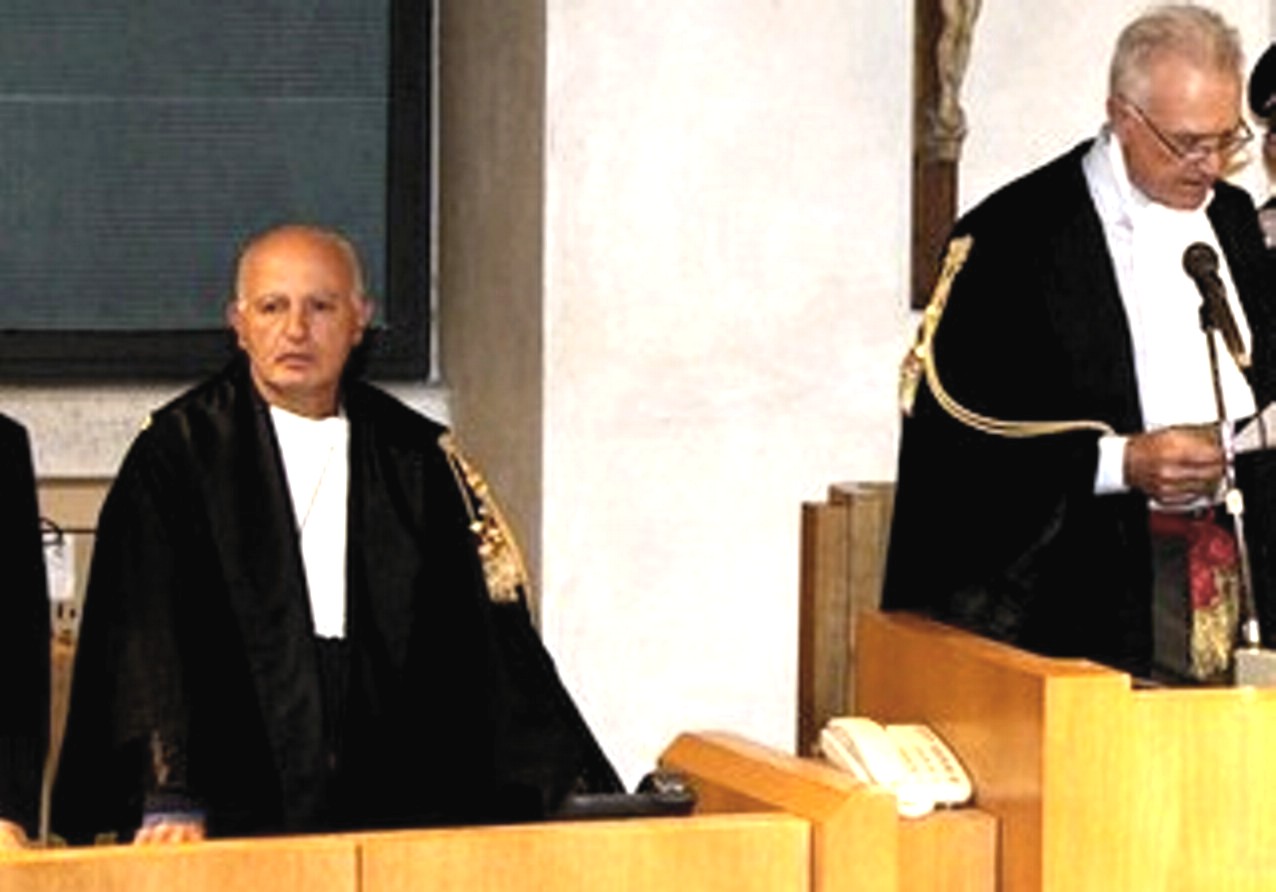
Thursday, July 19, 2012
This Formidable Prosecution Appeal To The Supreme Court Is Placed On The Agenda Next March
Posted by Peter Quennell

The Associated Press once again reveals its strong systematic anti-Italy bias in reporting the scheduling of the appeal.
Its headline on the report it sent out to thousands of its owners the media outlets reads “Amanda Knox Case: Acquittal Appeal Set For March By Italy”
Huh? That is the guts of the thing?
Well, hardly.
First, defense chances are slim, as there is no question that Knox did point falsely to Lumumba. On tape she even admitted that to her own mother, and her various explanations on the stand at trial simply dropped her in it some more.
That defense appeal could be dismissed in a sentence or two. It is simply grandstanding.
And second, vastly more importantly because this could lead to a complete retrial back in Perugia the AP headline and story should have fully explained the real 80,000 pound gorilla in the room.
This is the appeal that the Chief Prosecutor for Umbria Dr Galati has filed. The Associated Press has never told the global audience either what is in the prosecution appeal or precisely who Dr Galati is. Not even a hint.
Dr Galati was a Deputy Chief Prosecutor at the Supreme Court and is one of the most powerful and experienced in Italy. Why was he not quoted in the AP’s story?
Here is the real story of his appeal that the Associated Press doesn’t seem to want the global audience to know. First posted here back on 14 February when Dr Galati called his press conference on the appeal.
Italian lawyers are already remarking that Dr Galati’s appeal as summarised below is as tough as they ever get.
In their view the Hellman report reads more like a defense brief than a balanced appeal-court outcome in a murder trial. Both judges were put on the case on mysterious instructions from Rome, suggesting that the minister of justice had perhaps been leaned on - the judge pushed aside was extremely annoyed.
Both Judge Hellmann and Judge Zanetti, while undeniably good judges in their own fields (business and civil), are vastly less experienced at criminal trials than either Judge Micheli or Judge Massei. The entry in the Italian Wikipedia describes them thus.
Although the Assize Court of Appeal was to be chaired by Dr. Sergio Matteini Chiari, Chairman of the Criminal Division of the Court of Appeal in Perugia, in circumstances not well understood Dr. Claudio Pratillo Hellmann, who chairs the Labor Chamber of the Court, has been called on to preside over the appeal court,
The judge to the side of the main judge, Dr. Massimo Zanetti, came from the Civil Section, and both had had limited experience with criminal trials both rather remote in time (only the cases of Spoleto and Orvieto).
Judge Hellmann’s announcement of the verdict on the night was very odd, suggesting he had been outnumbered and was embarrassed. Remarks he made the next day seemed to confirm that. The weak sentencing report is said to be not his work, and was written by Judge Zanetti.
The Supreme Court of Cassation could insist on a complete new appeal trial or a partial new trial in Perugia if it accepts any of Dr Galati’s arguments at all. His appeal statement appeal is in three tiers, and a reversal could be ordered at any tier..
1. The Hellmann Court’s wide scope was illegally far too wide
Italian judicial code is very clear on this. They MUST stick to just the appealed items and not wander all over the map. Judge Zanetti was quite wrong at the start to declare that everything was open except the fact that Meredith had been murdered.
2. The DNA consultancy by Stefano Conti and Carla Vecchiotti was illegal
Defenses had every chance to attend the Scientific Police testing the first time around. It was a slippery dodge to skip those tests and then slime them. They had every opportunity at trial to throw aspersions. They are not meant to shop around.
3. There are many problems of wrong logic, evidence, and witnesses
The Massei trial sat through weeks and weeks of skilled prosecution presentations of the evidence including the forensic evidence and the many witnesses. The Hellman court got to see almost none of this and heard mostly from the defense.
This translation is from Umbria24 by our main poster ZiaK.
Meredith case: the prosecution appeals to Cassation: the acquittal verdict should be “nullified”.
For the Chief Magistrates of the [Umbria] Prosecution, “it was almost exclusively the defence arguments which were taken heed of”
By Francesca Marruco
The first-level conviction verdict was “complete and thorough” while the verdict of the second-level is “contradictory and illogical”. For this reason, the General Prosecution of Perugia asks the Cassation to revoke or invalidate it.
“We are still extremely convinced that Amanda and Raffaele are co-perpetrators of the murder of Meredith Kercher” said the Chief Prosecutor of Perugia, Giovanni Galati and the Deputy Chief Prosecutor, Giancarlo Costagliola.
Verdict that should be revoked
“The second-level verdict should be annulled/revoked…. There are precise reasons for revoking it”, Mr Galati went on to say. In the Hellman reasoning report on the verdict with which the second-level judges acquitted the ex-boyfriend and girlfriend “there are so many errors, and many omissions. There is inconsistency in the grounds for judgement, which brings us to nothing.”
“It is as if they had ruled ex novo [anew] on Meredith’s murder” added the Deputy Prosecutor, Giancarlo Costagliola, “basing their decision solely on the arguments of the defence.”
“Normally the appeal judge evaluates the reasoning procedure of the first-instance judge and compares it to new elements. But this one missed that out altogether: there is no comparison between the checks carried out in the first and second instances. Only what was carried out during the appeal was evaluated.”
Only defence arguments were taken heed of
For the magistrates, in fact, the second-level judges “took heed, almost exclusively, of the arguments of the defence consultants or the reconstruction hypotheses that were largely to the benefit of the defense theses”.
The prosecutors who authored the appeal [to Cassation] also criticized the “method used”. “The first-instance verdict”, they wrote, “was summarized in just a few lines”,
“The verdict [which we] challenge completely ignored all the other aspects which corresponded with the accusation’s hypothesis, all the aspects which, on the contrary - as was seen in the reasoning report of the first-instance verdict - had been rigorously pointed out and considered by the Assizes Court [trial court] in its decision.”
“In examining the individual [items of] evidence, the challenged sentence has fallen into consistent procedural error in the weaknesses and evident illogicality of the grounds for its decision.”
Prejudice by the two appeal judges
For the General Prosecution magistrates, the second-level [first appeal] judges appear to have shown “a sort of prejudice” with the “infelicitous preamble of the judge [the author], who is supposed to be impartial”, when he declared that “nothing is certain except the death of Meredith Kercher”, which to the others [Mr Galati and Mr Costagliola] is nothing more than “a resounding preview/forecast of the judgement” and a “disconcerting” affirmation.
The ten points of the appealThe reasons for the appeal to Cassation which Perugia’s General Prosecution presented today against the acquittal verdict of Amanda and Raffaele are based on ten points of the second-level verdict.
The first is the lack of grounds for the decision, in the decree of 18 December 2010, to allow the forensic testimony/expert witness in the appeal judgement.
The second, in contrast, concerns a contrary decision: the decision to not allow a new forensic investigation requested by the prosecution at the end of the ruling discussion. In the appeal to Cassation it is written that the Appeal Court’s rejection reveals “contradictoriness/contrariness and demonstrates manifest illogicality in the grounds for the judgement/reasoning report”.
The other points deal with the decision by the Appeal court of Assizes of Perugia to not hear the witness Aviello, also the definition of “unreliable” [in the Hellman Report] with reference to the witnesses Roberto Quintavalle and and Antonio Curatolo, also the time of death of Meredith Kercher, also on the genetic investigations.
As well as the analyses of the prints and other traces, also the presence of Amanda and Sollecito in via della Pergola, also the simulation of a crime [the staged break-in], and also the exclusion of the aggravating circumstance of the crime of “calumny”.
Missing assumption/acceptance of decisive evidence
In the appeal to Cassation there is also mention of the “missing assumption/acceptance of a decisive proof”
In other words, of that proof [presented at trial court] which consisted of “the carrying out of the genetic analysis on the sample taken from the knife by the experts appointed by the Court during the appeal judgement, who did not carry out the analyses of that sample, thus violating a specific request contained in the [orders given to them] when they were assigned to the expert-witness post”
“In the second-level [Hellman] verdict”, the magistrates said, “the judges sought to refer to this in their own way, by speaking of an “experimental method” by which these tests/checks could be carried out.
But this is not the case”, said Deputy Chief Prosecutor Giancarlo Costagliola: “Dr Novelli [the prosecution’s DNA consultant at appeal] spoke of cutting-edge technology, not of experimental methods”.
Wednesday, July 04, 2012
The Hands Of Time Video With Screenplay By Amanda Knox - A Confessional Obsession?
Posted by Fly By Night & Thundering
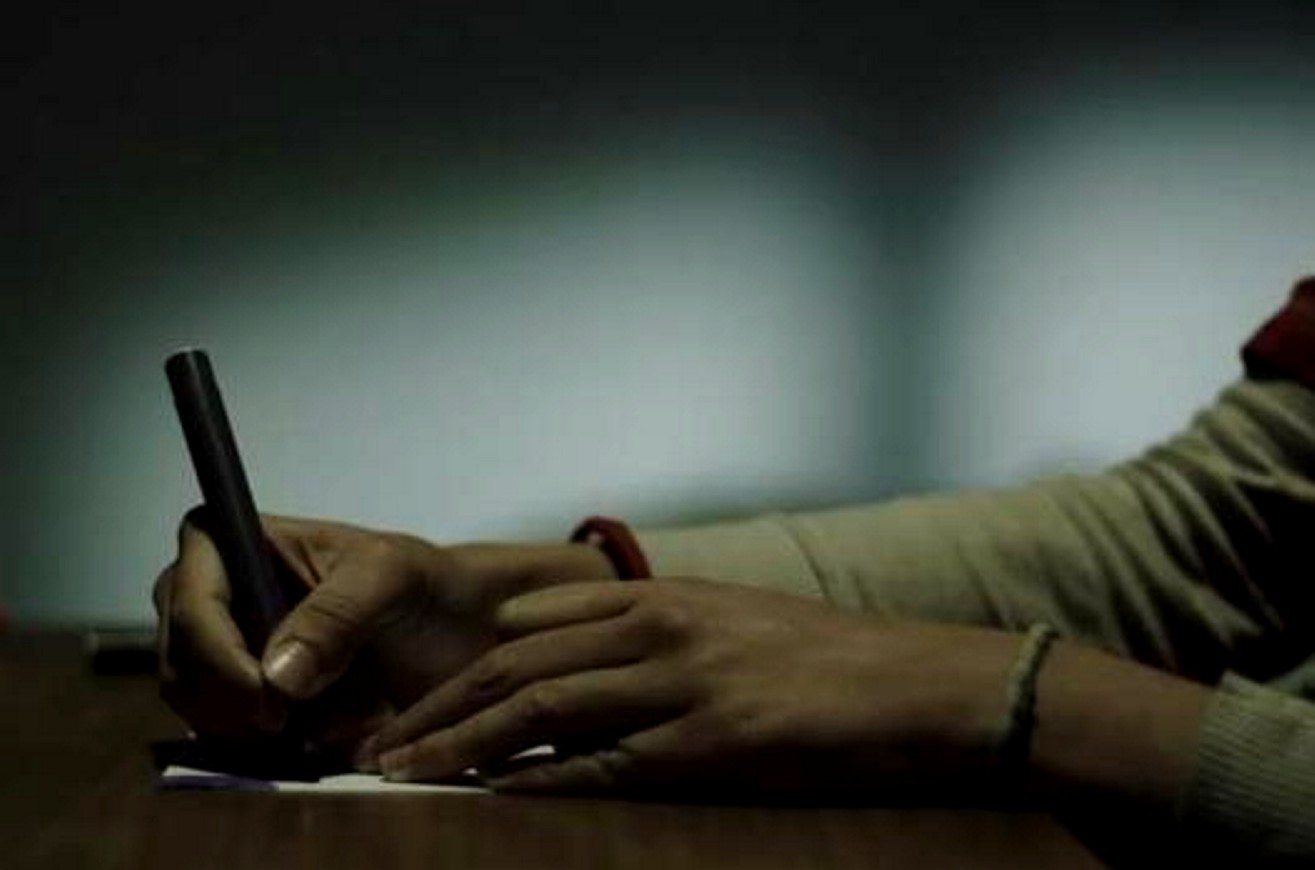
Amanda Knox rarely, if ever, mentions her “˜close friend’, murder victim Meredith Kercher. Perhaps out of her self-proclaimed desire to “˜move on with her life’.
So the recent Hands of Time (H.O.T.) music video The Mistral Blows which was posted on YouTube with a screenplay attributed to the Seattle native is nothing if not astonishing.
Whilst there is some discussion as to whether Amanda Knox wrote the entire screenplay, or a section of it, or whether the screenplay was created through a merging of several versions, the screenplay is clearly attributed to her in the credits that appear on the video.
Crediting Amanda Knox with the screenplay is repeatedly emphasized by H.O.T. themselves who posted multiple Twitter entries:
And this screenplay does Amanda Knox and her claims of innocence in the brutal murder of Meredith Kercher no favours at all.
Although provisionally “˜acquitted’ at the trial of second instance, Amanda Knox still stands accused of a capital crime, aspects of which she seems compelled to continue to portray in her various writings.
The hapless band H.O.T. might be well-advised to disassociate themselves from this endeavour and drop the video like a hot potato. The more-so as they have already burnt their fingers, tampering with the so-far elusive Brand Knox, finding themselves “˜forced to remove [clips of Knox dancing in Capanne] from the file, after a sudden, unexpected and “very strange” last-minute opposition from Amanda’s entourage.’
They state with a hint of bitterness:
The result? A compromise. The image of Knox dancing with carefree abandon in Capanne Prison (easily retrieved from other internet sites) remains, but is obliterated by a large “˜censored’ notice.
The reasons to attempt to disappear this video or, at the very least, any identifiable links with Knox, are abundantly clear to anyone having followed this dreadful case over the last four and a half years.
1) The video is riddled with allusions to the crime itself and features an easily-identifiable Amanda Knox as “˜heroine’ or “˜victim’ as she may now prefer to be seen and depending on how you look at it.
2) Any pre-book-release publicity will potentially devalue the carefully branded and preserved Amanda Knox product.
A cursory look at the video demonstrates the depraved audacity of the writer, a person who simultaneously insists she was found innocent of the crime of murder and of which she still stands accused.
The video features a Knox look-alike ““ recognizable by her clothing - in a prison-cum-house of horrors.
It opens with the heroine sitting down, colouring pictures in a prison cell. Amanda Knox was reported to spend time colouring pictures of her hands whilst in prison.
From there she leaves the cell and embarks on a journey through a range of horrifying experiences, until she finally flees the house but not the prison to which she is eternally condemned.
As she runs through the house of horrors she encounters:
1) Ghost-like figures lurching out at her hinting at the night of Halloween before the murder and the ghouls and demons of the house of horrors both in which the crime took place and in which she is forever imprisoned.
2) A tall, faceless black-haired figure dressed in black carrying an umbrella resembling Meredith Kercher dressed as a vampire on her last night alive, the red belt reminiscent of the fake costume blood and the actual blood spilled the night of the murder.
3) A faceless butcher figure dressed in a blood-stained apron holding a knife, who hands her a maggot-infested apple, reminiscent of the photograph of co-accused Raffaele Sollecito as posted on his Facebook page. The apple is suggestive of the poisoned apple offered by the witch to the innocent Snow White ““
4) Or a subliminal suggestion of Raffaele’s guilt in handing her the infested and poisonous apple “¦.. Remember: she claimed Raffaele may have pressed the murder knife with Meredith’s DNA into her hand whilst she was sleeping.
5) A figure tied to a chair covered in a red cloth hinting of the pools of blood and of Meredith unable to move to defend herself. As she reaches out to lift the red cloth the bound figure screams, sending her running out down staircases and steps and out of the house.
In the same way, witness Nora Cappezzali heard Meredith’s desperate, blood-curdling scream, followed shortly afterwards by running footsteps out of the house of horrors and onto the steel staircase near her home.
The video ends with the Knox look-alike remaining in prison. Both real and imagined.
H.O.T. suggest that the video and screenplay are a means of documenting the tale of the events in Perugia and, of course, Amanda Knox hopes to chronicle the nightmare in which she “˜innocently’ found herself. In so doing, she inadvertently describes the crime and the images, sounds and memories that will seemingly not leave her alone.
Not only are there many references to the crime, but there seems as well a clear jealous obsession with Meredith, given the numerous references and comparisons to Kristian Leontiou’s video Some Say in which Meredith hauntingly starred.
The Knox look-alike emulates Meredith from the Some Say video both in her dress and appearance as well as in her actions. She descends an old staircase, appears in doorways and through arches reminding us of the shots of Meredith and the church of the “˜Some Say’ video.
Emulation is a form of envy. Guilty or innocent, it seems Knox cannot exorcise her memories of the crime, and remains compelled to depict it in screenplays and short stories. Knox is seemingly still jealous of Meredith which had proved her original undoing. Here, in a bizarre reversal of reality, Meredith becomes the foreboding, frightening presence, whereas Knox is the shocked and terrified victim.
At a time when a tough Galati appeal to the Supreme Court and a $4 million book deal are on the table, the memory of Meredith and the crime seem to haunt and obsess Amanda Knox who may reveal a deep-seated need to confess. But while still accused, Amanda Knox cannot afford to engage in such obsessive, confessional activity.
Could this prove to be her final undoing?




